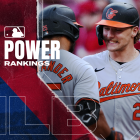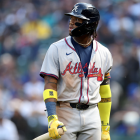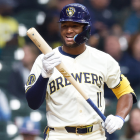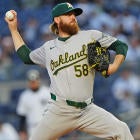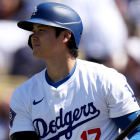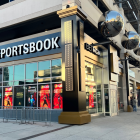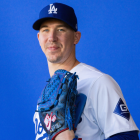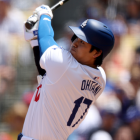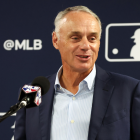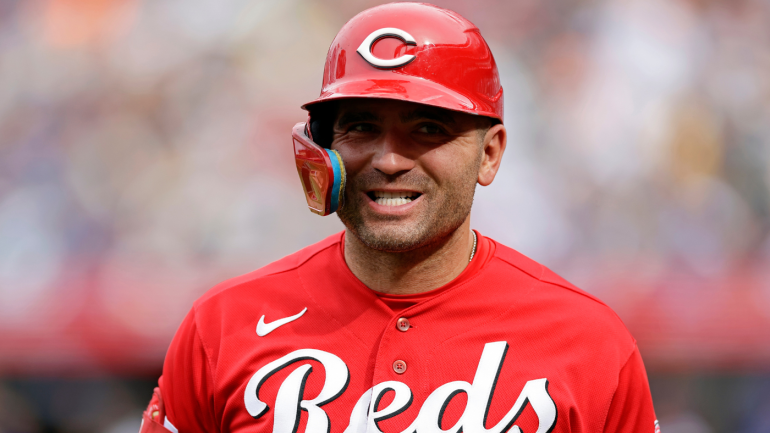
Major League Baseball's offseason is well underway, with transactions expected to pick up steam between now and the annual Winter Meetings (beginning on Dec. 3). Recently, CBS Sports ushered in the offseason by ranking the top 50 free agents available on the marketplace.
As is the case every year, there were several big-name players who didn't make the cut for various reasons. Rather than leave you in the dark about why those players were snubbed, below we've explained our thinking on five players in particular, including first baseman Joey Votto and righty Jack Flaherty.
Let's get to it.
1. Joey Votto, 1B
Votto, 40, is a former MVP Award winner and a six-time All-Star who became a free agent when the Reds declined his club option. If he plays on -- and he has suggested that he intends to return for what would be an 18th big-league season -- he'll have to don a different uniform for the first time in his career.
It's tempting to envision Votto as a part-time first baseman or DH who devours right-handed pitching. Alas, that image of him is outdated. He's been more productive without the platoon advantage recently, to the extent that his on-base percentage against righties hasn't cleared .300 since 2021.
Votto had some other worrisome signs emerge last season: he set new career-highs in pull, ground-ball, and pop-up rates -- all indications he's lost bat speed and barrel control. He also chased and whiffed more frequently than he had since at least 2015, suggesting his once-elite eye has slipped. This is very much a portrait of a hitter in deep decline. That's to be expected: again, he's 40, and he's had his share of injury issues in recent years.
You can understand, then, why we didn't feel Votto would be viewed as a priority target for most teams. We nevertheless hope he latches on somewhere, and that he's able to go out on both his terms and a high note.
2. Jack Flaherty, RHP
Flaherty, having turned 28 in October, is young by free-agent standards. It feels like just yesterday that he finished top-five in Cy Young Award voting, the culmination of a two-year, 61-start stretch that saw him amass a 135 ERA+ and a 3.62 strikeout-to-walk ratio. It wasn't yesterday that happened, though, it was way back in 2019, which may as well have been another lifetime ago.
Flaherty has since endured a four-year run that has seen him compile a 94 ERA+ and a 2.42 strikeout-to-walk ratio in 64 appearances (59 starts). The last time anyone saw him, he was pitching relief in a blowout playoff loss after a trade to the Orioles failed to restore him back to his factory settings.
To Flaherty's credit, he continued to manage quality of contact -- this season marked the third in four tries that he's posted an average exit velocity against under 88 mph. To his debit, well … there's everything else. His strikeout and walk rates have moved in the wrong direction, and it's even hard to find hope on a granular level. To wit, he used four pitches at least 5% of the time this season -- the second-lowest batting average against among the bunch was .290.
Flaherty feels a bit like Noah Syndergaard did last winter, where it's clear that they need to reimagine their games in order to get back on the right side of the ledger. Syndergaard tried his best to reinvent himself, it just didn't work out. We're not sure what the future holds for Flaherty -- hopefully a better fate -- but we wouldn't want to be the ones betting a multi-year deal on it.
3. Whit Merrifield, 2B/LF
In a weak market for middle infielders, you might suspect that someone like Merrfield, who made the most recent All-Star Game, would be in demand. Maybe, but we have some serious reservations about his game.
The short version goes like this. Merrifield is getting up there in age (his 35th birthday falls in January), and he doesn't excel at any aspect of the game. He doesn't hit for power or walk often, leaving him without an above-average offensive season since 2019. He has a reputation for being a good basestealer, yet he succeeded on just 26 of his 36 attempts despite the league introducing new rules that made thieving the easiest it's been during his career.
Merrifield continues to grade well defensively at second base, but Statcast's metrics found him to have performed poorly in the outfield corners. A decent amount of his appeal is his versatility. If teams share the same read of his defense, relegating him to the keystone, then that almost by default undercuts his perceived value.
It doesn't help that Merrifield seems to be aiming high, having declined his share of a mutual option worth $18 million. Perhaps he just wants to round out his career with the peace of mind that a multi-year deal provides. Otherwise, we're not so sure that he's going to be happy with how the winter plays out.
4. Joey Gallo, 1B/OF
Did you know that Gallo was technically an above-average hitter last season? It's true, he finished with a 101 OPS+ in 111 games with the Twins. He also posted his highest average exit velocity since the 2019 season, as well as the second-highest hard-hit percentage of his career. Factor in how Gallo is a two-time All-Star who only celebrated his 30th birthday on Nov. 19, and you would think he would merit a spot on the top 50.
We just couldn't bring ourselves to do it, not with Gallo morphing into the caricature his detractors used to portray him as being during his salad days.
Gallo struck out in about 43% of his plate appearances. He whiffed on 44% of his swings. He pulled 58% of his batted balls. In so many words, he became even more of a boom-or-bust hitter -- something we didn't think was possible. It's a formula that might work for stretches -- it objectively worked OK in 2023 -- but we wouldn't want to bet on it working often or for long.
5. David Robertson, RHP
We'll close with, what else, a closer.
Robertson was en route to another strong season before the Mets traded him to the Marlins at the deadline. The swap was widely criticized by other front offices who thought Miami overpaid by parting with two intriguing young prospects (infielder Marco Vargas and catcher Ronald Hernandez) for a rental reliever. With the benefit of hindsight, we can confirm the deal was a stinker.
Robertson blew three saves in seven chances and was charged with four losses in 22 appearances. (Wins and losses don't tell the story for starting pitchers; for closers, though, they're a little more descriptive.) What's more is that he walked 12 of the 97 batters he faced with the Marlins after walking 13 of the 172 batters he faced with the Mets. The Marlins still made the playoffs, but Robertson certainly made their path to October more stressful.
The odd thing is that Robertson didn't alter much after changing teams. His release point was roughly the same; he threw nearly the same percentage of strikes (63.6% instead of 64.1%); and so on. The most noticeable difference, outside of the results themselves, was a modified approach. He threw more cutters and sliders and fewer curves. Does that explain what happened in Miami? No, we don't think so.
Some teams will shrug at Robertson's final couple months and pursue him anyway, reasoning that weird things happen with relievers in small samples. That's undeniable. We just felt better about other arms.
























